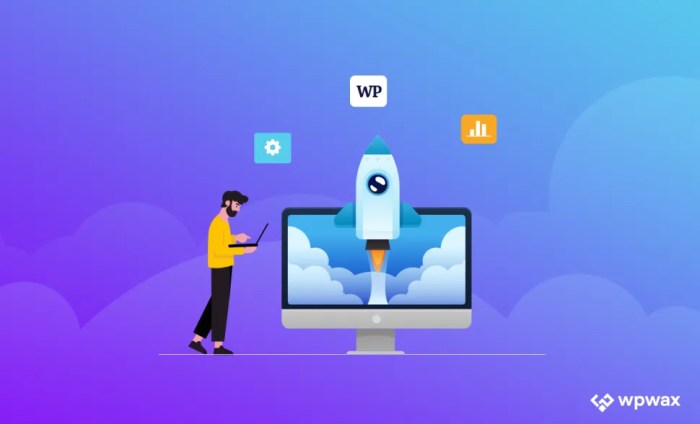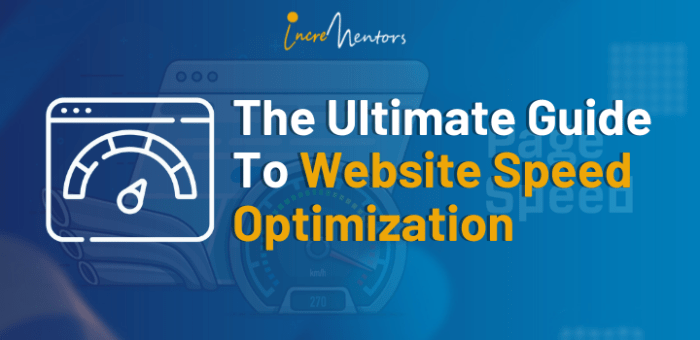Optimizing Website Speed is crucial for a top-notch user experience and improved rankings. Dive into this guide filled with tips and tricks to enhance your website’s speed and performance.
Understanding the impact of speed, evaluating current performance, optimizing images, and minifying resources are just a few of the key areas we’ll explore in this journey to turbocharging your website.
Understanding Website Speed
Website speed is crucial for providing a smooth and efficient user experience. Slow-loading websites can frustrate visitors and lead to high bounce rates, negatively impacting conversion rates and overall user satisfaction.
Factors Affecting Website Speed
- Server Response Time: The time it takes for your server to respond to a request plays a significant role in website speed.
- Image Size and Optimization: Large, unoptimized images can slow down a website significantly. Properly optimizing images can improve loading times.
- Code Efficiency: Clean, streamlined code can help speed up a website, while messy or bloated code can slow it down.
- Browser Cache: Utilizing browser caching can reduce loading times for returning visitors by storing static resources locally.
Website Speed and Rankings
Website speed is a crucial factor in determining rankings. Search engines like Google prioritize fast-loading websites in their search results, as they provide a better user experience. Slow websites may be penalized and pushed down in search rankings, affecting visibility and organic traffic.
Website Speed and Bounce Rates
High bounce rates are often associated with slow-loading websites. Visitors are more likely to leave a website if it takes too long to load, leading to a negative impact on bounce rates. Improving website speed can help reduce bounce rates and keep visitors engaged with your content.
Evaluating Current Website Speed: Optimizing Website Speed

When it comes to evaluating the speed of your website, there are several methods and tools available to help you assess its performance. By measuring website speed effectively, you can identify areas for improvement and ensure a better user experience for your visitors.
Methods to Measure Website Speed Effectively
- Page Load Time: Measure the time it takes for your website to load completely. This can be done using tools like Google PageSpeed Insights or GTmetrix.
- Time to First Byte (TTFB): Evaluate the time it takes for the first byte of data to be received by a visitor’s browser. A lower TTFB indicates faster website speed.
- Render Time: Assess how quickly your website content is displayed on the user’s screen. Tools like WebPageTest can help you measure render time effectively.
Tools Available for Analyzing Website Speed
- Google PageSpeed Insights: Provides a comprehensive analysis of your website speed and offers suggestions for improvement.
- GTmetrix: Offers detailed performance reports, including page load time, total page size, and number of requests.
- WebPageTest: Allows you to test your website speed from multiple locations and provides insights into performance bottlenecks.
Interpreting Data from Speed Tests
- Look for Opportunities for Improvement: Identify areas where your website speed can be optimized, such as image compression or code minification.
- Understand Key Metrics: Pay attention to metrics like First Contentful Paint (FCP) and Time to Interactive (TTI) to gauge user experience.
- Compare Results Over Time: Track changes in website speed to measure the impact of optimizations and updates.
Comparison of Different Speed Testing Tools
| Tool | Key Features |
|---|---|
| Google PageSpeed Insights | Insights for mobile and desktop performance, specific optimization recommendations. |
| GTmetrix | Waterfall breakdown of page elements, historical data tracking. |
| WebPageTest | Multi-location testing, advanced customization options for testing parameters. |
Optimizing Images for Speed
When it comes to optimizing website speed, image optimization plays a crucial role in enhancing overall performance. Images are often the largest elements on a webpage, so reducing their file sizes can significantly improve loading times.
Reducing Image File Sizes
- Utilize image compression tools like Adobe Photoshop, TinyPNG, or ImageOptim to reduce file sizes without losing quality.
- Consider converting images to more efficient formats like WebP or JPEG 2000 for better compression.
- Remove any metadata or unnecessary information from images to further reduce file sizes.
Responsive Images for Faster Loading
- Implement srcset attribute in HTML to provide multiple image options based on device resolution, ensuring faster loading times on different screens.
- Use the sizes attribute to specify the display size of the image, allowing browsers to choose the most appropriate image version for optimal speed.
Lazy Loading of Images
- Implement lazy loading to defer offscreen images until the user scrolls to them, improving initial page load times.
- Consider using JavaScript libraries like LazyLoad or Intersection Observer API to easily add lazy loading functionality to your website.
Minifying Resources

Minifying resources refers to the process of reducing the size of CSS, JavaScript, and HTML files by removing unnecessary characters like white spaces, comments, and formatting. This optimization technique plays a crucial role in improving website speed by reducing the amount of data that needs to be transferred between the server and the user’s browser.
Minifying CSS and JavaScript Files
When it comes to minifying CSS and JavaScript files, there are a few steps you can follow:
- Use online tools or build processes to automatically minify your files.
- Manually remove unnecessary spaces, comments, and line breaks from your code.
- Consider using a Content Delivery Network (CDN) that offers minification services.
Combining and Compressing Resources
Combining and compressing resources involves merging multiple CSS and JavaScript files into a single file and then compressing it to reduce its size. This process helps reduce the number of HTTP requests made by the browser, ultimately improving website speed. It is recommended to use tools like Gzip to compress files and tools like Grunt or Webpack to combine them efficiently.
Leveraging Browser Caching, Optimizing Website Speed
Browser caching allows certain files to be stored locally on a user’s device, reducing the need to download them every time the user visits a website. To leverage browser caching for faster loading times, you can set expiration dates for your resources in the HTTP headers. This ensures that the browser will only download updated files when necessary, leading to improved website performance.